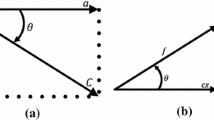Abstract
In this paper, we present and investigate the analytical properties of a new set of orthogonal basis functions derived from the block-pulse functions. Also, we present a numerical method based on this new class of functions to solve nonlinear Volterra–Fredholm integral equations. In particular, an alternative and efficient method based on the formalism of artificial neural networks is discussed. The efficiency of the mentioned approach is theoretically justified and illustrated through several qualitative and quantitative examples.








Similar content being viewed by others
References
Atkinson K (1997) The numerical solution of integral equations of the second kind. Cambridge University Press, Cambridge
Babolian E, Masouri Z, Hatamzadeh-Varmazyar S (2009) Numerical solution of nonlinear Volterra–Fredholm integro-differential equations via direct method using triangular functions. Comput Math Appl 58(2):239–247
Babolian E, Shahsavaran A (2009) Numerical solution of nonlinear Fredholm integral equations of the second kind using Haar wavelets. J Comput Appl Math 225(1):87–95
Biazar J, Ghazvini H (2008) Numerical solution for special non-linear Fredholm integral equation by HPM. Appl Math Comput 195(2):681–687
Capuano N, DAniello G, Gaeta A, Miranda S (2015) A personality based adaptive approach for information systems. Comput Hum Behav 44:156–165
Chen G (2004) Stability of nonlinear systems. In: Encyclopedia of RF and Microwave Engineering
Dastjerdi HL, Ghaini FM (2012) Numerical solution of Volterra-Fredholm integral equations by moving least square method and Chebyshev polynomials. Appl Math Model 36(7):3283–3288
Deb A, Dasgupta A, Sarkar G (2006) A new set of orthogonal functions and its application to the analysis of dynamic systems. J Frankl Inst 343(1):1–26
Deb A, Roychoudhury S, Sarkar G (2016) Analysis and identification of time-invariant systems, time-varying systems, and multi-delay systems using orthogonal hybrid functions: theory and algorithms withMATLAB®, vol 46. Springer, Kolkota
Deb A, Sarkar G, Sengupta A (2011) Triangular orthogonal functions for the analysis of continuous time systems. Anthem Press, London
Effati S, Buzhabadi R (2012) A neural network approach for solving Fredholm integral equations of the second kind. Neural Comput Appl 21(5):843–852
Gaeta M, Loia V, Tomasiello S (2013) A generalized functional network for a classifier-quantifiers scheme in a gas-sensing system. Int J Intell Syst 28(10):988–1009
Hahn W (1967) Stability of motion. Springer, Berlin
Hale J, Kocak H (1991) Dynamics and bifurcations. Springer, New York
Han Z, Li S, Cao Q (2012) Triangular orthogonal functions for nonlinear constrained optimal control problems. Res J Appl Sci Eng Technol 4(12):1822–1827
Haykin S (1999) Neural networks a comprehensive foundation, 2nd edn. Pretice Hall International, New York
Jafarian A, Measoomy S, Abbasbandy S (2015) Artificial neural networks based modeling for solving Volterra integral equations system. Appl Soft Comput 27:391–398
Khalil HK (1988) Nonlinear systems. McMillan, New York
Lagaris IE, Likas A, Fotiadis DI (1998) Artificial neural networks for solving ordinary and partial differential equations. IEEE Trans Neural Netw 9(5):987–1000
Marcus C, Westervelt R (1989) Dynamics of iterated-map neural networks. Phys Rev A 40(1):501
Michel AN, Farrell JA, Porod W (1989) Qualitative analysis of neural networks. IEEE Trans Circuits Syst 36(2):229–243
Mirzaee F (2017) Numerical solution of nonlinear Fredholm–Volterra integral equations via Bell polynomials. Comput Methods Differ Equ 5(2):88–102
Mirzaee F, Hadadiyan E (2012) Approximate solutions for mixed nonlinear Volterra–Fredholm type integral equations via modified block-pulse functions. J Assoc Arab Univ Basic Appl Sci 12(1):65–73
Mirzaee F, Hadadiyan E (2016) Numerical solution of Volterra–Fredholm integral equations via modification of hat functions. Appl Math Comput 280:110–123
Mirzaee F, Hadadiyan E (2017) Using operational matrix for solving nonlinear class of mixed Volterra–Fredholm integral equations. Math Methods Appl Sci 40(10):3433–3444
Mirzaee F, Hoseini AA (2013) Numerical solution of nonlinear Volterra-Fredholm integral equations using hybrid of block-pulse functions and Taylor series. Alex Eng J 52(3):551–555
Mirzaee F, Hoseini SF (2016) Application of Fibonacci collocation method for solving Volterra–Fredholm integral equations. Appl Math Comput 273:637–644
Ordokhani Y, Razzaghi M (2008) Solution of nonlinear Volterra–Fredholm–Hammerstein integral equations via a collocation method and rationalized Haar functions. Appl Math Lett 21(1):4–9
Paripour M, Kamyar M (2013) Numerical solution of nonlinear Volterra–Fredholm integral equations by using new basis functions. Commun Numer Anal 1(17):1–12
Rampone S, Pierro V, Troiano L, Pinto IM (2013) Neural network aided glitch-burst discrimination and glitch classification. Int J Mod Phys C 24(11):1350,084
Acknowledgements
The authors wishes to thank the anonymous reviewers and the editor in charge of handling this paper for all their criticisms and comments. All of their suggestions contributed significantly to improve the quality of this work.
Author information
Authors and Affiliations
Corresponding author
Ethics declarations
Conflict of interest
The authors declare that they have no potential conflict of interest.
Additional information
Publisher's Note
Springer Nature remains neutral with regard to jurisdictional claims in published maps and institutional affiliations.
Rights and permissions
About this article
Cite this article
Tomasiello, S., Macías-Díaz, J.E., Khastan, A. et al. New sinusoidal basis functions and a neural network approach to solve nonlinear Volterra–Fredholm integral equations. Neural Comput & Applic 31, 4865–4878 (2019). https://doi.org/10.1007/s00521-018-03984-y
Received:
Accepted:
Published:
Issue Date:
DOI: https://doi.org/10.1007/s00521-018-03984-y




